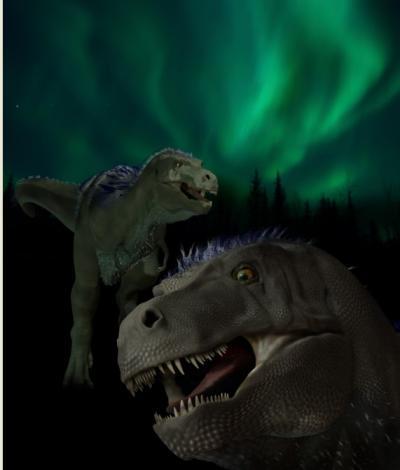A 70 million year old fossil found in the Late Cretaceous sediments of Alaska reveals a new small tyrannosaur named Nanuqsaurus hoglundi.
Tyrannosaurs, the lineage of carnivorous theropod ("beast feet") dinosaurs that include T. rex, have captivated our attention, but the majority of our knowledge about this group comes from fossils from low- to mid-latitudes of North America and Asia.
In a new paper, co-authors Anthony Fiorillo and Ronald S. Tykoski from the Perot Museum of Nature and Science, Texas, and colleagues, analyzed the partial skull roof, maxilla, and jaw, recovered from Prince Creek Formation in Northern Alaska, of a dinosaur originally believed to belong to a different species, and then compared the fossils to known tyrannosaurine species.
According to the results of the authors' analysis, the cranial bones represent Nanuqsaurus hoglundi, a new tyrannosaurine species closely related to two other tyrannosaurides, Tarbosaurus and Tyrannosaurus. This new dinosaur is estimated to be relatively small, with an adult skull length estimated at 25 inches, compared to 60 inches for T. rex. The new species likely inhabited a seasonally extreme, high-latitude continental environment on the northernmost edge of Cretaceous North America.

Nanuqsaurus hoglundi, holotype, DMNH 21461. A. Reconstruction of a generalized tyrannosaurine skull, with preserved elements of holotype shown in white. Arrow points to autapomorphic, reduced, first two dentary teeth. B–E. Photographs and interpretive line drawings of right maxilla piece in medial (B, C); and dorsal (D, E) views. F–I. Photographs and interpretive line drawings of partial skull roof in dorsal (F, G); and rostrolateral (H, I) views. J–M, partial left dentary in lateral (J); medial (K); dorsal (L) views; and close-up of mesial alveoli in dorsal (M) views. Abbreviations: a, alveolus, with number indicating position in tooth row; d, dentary tooth, with number indicating position in tooth row; f, frontal; gr, orbital groove; lac.f, lacrimal facet of frontal; l.f, left frontal; na, nasal contact surface; oif, oral intramandibular foramen; p, parietal; po.f, postorbital facet of frontal; prf.f, prefrontal facet of frontal;. r.f, right frontal; ri, ridge separating sockets in nasal articulation of maxilla; rpf, rostral process of frontal between prefrontal and lacrimal facets; rsp, rostral spur of parietal; sac, sagittal crest; so, socket for nasal articulation of maxilla; stf; supratemporal fossa. Gray fill indicates missing bone or broken bone surfaces and cracks. Scale bar in A equals 10 cm. Scale bars in B–L equal 5 cm. Scale bar in M equals 1 cm. Credit and link: doi:10.1371/journal.pone.0091287
The authors suggest that the smaller body size of N. hoglundi compared to most tyrannosaurids from lower latitudes may reflect an adaptation to variability in resources in the arctic seasons. Further diversification may stem from the dinosaurs' partial isolation in the north by land barriers, such as the east-west running Brooks Range.
Although the preserved elements of N. hoglundi are fragments, the authors point to morphological data to provide support for its place among derived tyrannosaurines. This discovery may provide new insights into the adaptability and evolution of tyrannosaurs in a different environment, the Arctic.

Paleontologists from the Perot Museum of Nature and Science in Dallas have discovered a new genus and species of a pygmy tyrannosaur that once roamed the ancient Arctic lands of Northern Alaska. The animal has been formally named Nanuqsaurus hoglundi. Credit: ILLUSTRATION BY KAREN CARR)
"The 'pygmy tyrannosaur' alone is really cool because it tells us something about what the environment was like in the ancient Arctic," said Fiorillo. "But what makes this discovery even more exciting is that Nanuqsaurus hoglundi also tells us about the biological richness of the ancient polar world during a time when the Earth was very warm compared to today."





Comments